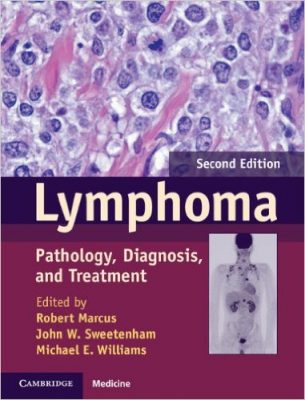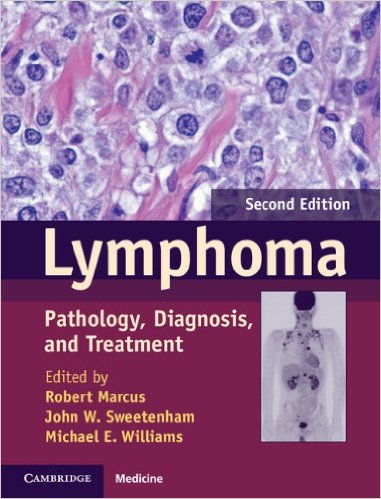 Editors: Robert Marcus, John W. Sweetenham, and Michael E. Williams
Editors: Robert Marcus, John W. Sweetenham, and Michael E. Williams
Publisher: Cambridge University Press – 311 pages
Book Review by: Nano Khilnani
While this book is intended for hematologists and specialists in cancer of the blood, it could also be read by patients who have one form of lymphoma or the other, and by their relatives who want to understand this disorder or disease. So we consulted a resource for lay people.
A lymphoma is defined on Wikipedia as a blood cell tumor that develops from lymphocytes: a type of white blood cell. The name often refers to just the cancerous ones rather than all such as tumors. Signs and symptoms may include enlarged lymph nodes, fever, drenching sweats, unintended weight loss, itching, and constantly feeling tired. The enlarged lymph nodes are usually painless, and the sweats are most common at night.
A group of people led by the three editors named above decided to once again in 2014 share their knowledge, experience, and insight on lymphomas and put together this second edition. An earlier time was in 2007 when the first edition was published.
Thirty-eight specialists (including the three editors named above), mainly in hematology and oncology, but also in related fields such as dermatology, histopathology, pathology, radiology, and others, wrote the contents for this book. They are from the United States and 5 nations in Europe: France, Germany, Italy, Switzerland, and the United Kingdom. We list below the titles of the 17 chapters to give you an overview of what you will find in this book:
- Epidemiology
- Prognostic factors for lymphomas
- Imaging
- Clinical trials for lymphomas
- Hodgkin lymphoma
- Follicular lymphoma
- MALT and other marginal zone lymphoma
- Small lymphocytic lymphoma / chronic lymphocytic leukemia
- Waldenstrom’s macroglobulinemia / lymphoplasmacytic lymphoma
- Mantle cell lymphoma
- Burkitt and lymphoblastic lymphoma: clinical therapy and outcome
- Therapy of diffuse large B-cell lymphoma
- Central nervous system lymphomas
- T-cell non-Hodgkin lymphoma
- Primary cutaneous lymphoma
- Lymphoma in the immunosuppresed
- Atypical lymphoproliferative, histocytic, and dendritic cell disorders
Each chapter is organized in a simple yet elegant fashion typically consisting of these parts:
- Chapter title with bylines
- Introduction
- Initial Topic (e.g. Background, Epidemiology, Staging Techniques, etc.)
- Other Topics with Subtopics
- Summary or Conclusion
- Further Reading
The editors and the authors of each chapter provide images to enhance understanding of the topics presented and discussed which improves retention and recall by the readers. The visuals typically consist of charts, micrographs, photos, radiographs, sketches, tables, and x-rays.
In recent decades, advances in the knowledge base of lymphomas through clinical trials and research studies, have helped doctors better diagnose and treat this class of diseases intheir patients, the editors point out.
Also, improvements in imaging capabilities have grown exponentially in recent years. This has deepened our understanding of the molecular biology and genetics of lymphomas, thereby reducing the time required for diagnosis, and enhancing its quality.
Further, new treatments provided with immunotherapy drugs and the next generation of antibodies have helped in the fight against lymphomas.
All such information is provided in this second edition. This is an excellent book on lymphomas.
Editors:
Robert Marcus is Consultant Haematologist at King’s College hospital NHS Foundation Trust in London, United Kingdom.
John W. Sweetenham is Professor Internal Medicine and Executive Medical Director of the Huntsman Cancer Institute at the University of Utah in Salt Lake City, Utah.
Michael E. Williams is Byrd S. Leavell Professor of Medicine, Professor of Pathology, and Director of the Hematologic Malignancies Section in the Hematology / Oncology Division at the University of Virginia School of Medicine in Charlottesville, Virginia.







